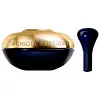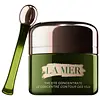What's inside
What's inside
 Key Ingredients
Key Ingredients

 Benefits
Benefits

 Concerns
Concerns

 Ingredients Side-by-side
Ingredients Side-by-side

Water
Skin ConditioningGlycerin
HumectantLimnanthes Alba Seed Oil
Skin ConditioningButylene Glycol
HumectantPropanediol
SolventButyrospermum Parkii Butter
Skin ConditioningPentylene Glycol
Skin ConditioningEthylhexyl Palmitate
EmollientLauroyl Lysine
Skin ConditioningGastrodia Elata Root Extract
Skin ConditioningPhytosteryl/Octyldodecyl Lauroyl Glutamate
Skin ConditioningHydrogenated Lecithin
EmulsifyingSodium Polyacrylate
AbsorbentEctoin
Skin ConditioningAvena Sativa Kernel Extract
AbrasiveHydroxyacetophenone
AntioxidantCellulose
AbsorbentChlorphenesin
AntimicrobialParfum
Masking1,2-Hexanediol
Skin ConditioningCaprylyl Glycol
EmollientSynthetic Fluorphlogopite
Silica
AbrasiveAcrylates/C10-30 Alkyl Acrylate Crosspolymer
Emulsion StabilisingSodium Stearoyl Glutamate
CleansingTocopheryl Acetate
AntioxidantCI 77891
Cosmetic ColorantPhytosterols
Skin ConditioningDendrobium Nobile Extract
Skin ConditioningAdenosine
Skin ConditioningTrihydroxystearin
Skin ConditioningSodium Benzoate
MaskingXanthan Gum
EmulsifyingBacillus Ferment
Skin ConditioningGlyceryl Caprylate
EmollientTin Oxide
AbrasiveTropaeolum Majus Flower/Leaf/Stem Extract
Skin ConditioningSodium Hyaluronate
HumectantGlycine Soja Oil
EmollientTocopherol
AntioxidantAcetyl Hexapeptide-8
HumectantDiamond Powder
AbrasivePentaerythrityl Tetra-Di-T-Butyl Hydroxyhydrocinnamate
AntioxidantGlucomannan
Skin ConditioningWater, Glycerin, Limnanthes Alba Seed Oil, Butylene Glycol, Propanediol, Butyrospermum Parkii Butter, Pentylene Glycol, Ethylhexyl Palmitate, Lauroyl Lysine, Gastrodia Elata Root Extract, Phytosteryl/Octyldodecyl Lauroyl Glutamate, Hydrogenated Lecithin, Sodium Polyacrylate, Ectoin, Avena Sativa Kernel Extract, Hydroxyacetophenone, Cellulose, Chlorphenesin, Parfum, 1,2-Hexanediol, Caprylyl Glycol, Synthetic Fluorphlogopite, Silica, Acrylates/C10-30 Alkyl Acrylate Crosspolymer, Sodium Stearoyl Glutamate, Tocopheryl Acetate, CI 77891, Phytosterols, Dendrobium Nobile Extract, Adenosine, Trihydroxystearin, Sodium Benzoate, Xanthan Gum, Bacillus Ferment, Glyceryl Caprylate, Tin Oxide, Tropaeolum Majus Flower/Leaf/Stem Extract, Sodium Hyaluronate, Glycine Soja Oil, Tocopherol, Acetyl Hexapeptide-8, Diamond Powder, Pentaerythrityl Tetra-Di-T-Butyl Hydroxyhydrocinnamate, Glucomannan
Algae Extract
EmollientWater
Skin ConditioningDimethicone
EmollientIsododecane
EmollientGlycerin
HumectantHydrogenated Polyisobutene
EmollientTrisiloxane
Skin ConditioningCaprylic/Capric/Myristic/Stearic Triglyceride
EmollientVinyl Dimethicone/Methicone Silsesquioxane Crosspolymer
Caprylic/Capric Triglyceride
MaskingMaris Sal
Skin ConditioningYeast Extract
Skin ConditioningHelichrysum Arenarium Extract
AntiseborrhoeicSesamum Indicum Seed Oil
EmollientMedicago Sativa Seed Powder
Skin ConditioningHelianthus Annuus Seedcake
AbrasivePrunus Amygdalus Dulcis Seed Meal
AbrasiveEucalyptus Globulus Leaf Oil
PerfumingSodium Gluconate
Skin ConditioningCopper Gluconate
Skin ConditioningCalcium Gluconate
HumectantMagnesium Gluconate
Skin ConditioningZinc Gluconate
Skin ConditioningTocopheryl Succinate
AntioxidantNiacin
SmoothingSesamum Indicum Seed Powder
Skin ConditioningAsparagopsis Armata Extract
Skin ProtectingLaminaria Digitata Extract
Skin ProtectingSaccharum Officinarum Extract
MoisturisingPhytosphingosine
Skin ConditioningEcklonia Cava Extract
Skin ConditioningCorallina Officinalis Extract
Skin ConditioningSodium Hyaluronate
HumectantSigesbeckia Orientalis Extract
Skin ConditioningPolygonum Fagopyrum Seed Extract
Skin ConditioningBrassica Campestris Seed Oil
Skin ConditioningPolyglyceryl-3 Diisostearate
EmulsifyingGlycyrrhiza Glabra Root Extract
BleachingAscophyllum Nodosum Extract
Skin ConditioningCitrus Aurantifolia Peel Extract
CleansingCucumis Sativus Fruit Extract
EmollientAcetyl Hexapeptide-8
HumectantAlthaea Officinalis Root Extract
Skin ConditioningOryza Sativa Bran Extract
Skin ConditioningTocopheryl Acetate
AntioxidantSaccharomyces Lysate Extract
HumectantMacadamia Integrifolia Seed Oil
Skin ConditioningDipeptide-2
Skin ConditioningGlyceryl Triacetyl Ricinoleate
EmollientPalmitoyl Tetrapeptide-7
Skin ConditioningCaffeine
Skin ConditioningTetraacetylphytosphingosine
Skin ConditioningLactis Proteinum
Skin ConditioningAcetyl Glucosamine
Skin ConditioningTriethylhexanoin
MaskingSorbitol
HumectantHordeum Vulgare Extract
EmollientGlycine Soja Protein
EmulsifyingCholesterol
EmollientHydrolyzed Yeast Protein
Skin ConditioningIsononyl Isononanoate
EmollientPropylene Glycol Dicaprate
EmollientCetyl PEG/PPG-10/1 Dimethicone
EmulsifyingCaprylyl Glycol
EmollientSucrose
HumectantPolysilicone-11
Dimethicone Crosspolymer
Emulsion StabilisingDimethicone Crosspolymer-3
Skin ConditioningSilica
AbrasiveNylon-12
Trimethylsiloxysilicate
EmollientSteareth-20
CleansingCalcium Chloride
AstringentHesperidin Methyl Chalcone
AntioxidantPEG/PPG-18/18 Dimethicone
EmulsifyingAlumina
AbrasiveTriethoxycaprylylsilane
Hydrogenated Vegetable Oil
EmollientAlcohol Denat.
AntimicrobialPropanediol
SolventParfum
MaskingBHT
AntioxidantPhenoxyethanol
PreservativePotassium Sorbate
PreservativeChlorhexidine Digluconate
AntimicrobialSodium Benzoate
MaskingMica
Cosmetic ColorantCI 77891
Cosmetic ColorantAlgae Extract, Water, Dimethicone, Isododecane, Glycerin, Hydrogenated Polyisobutene, Trisiloxane, Caprylic/Capric/Myristic/Stearic Triglyceride, Vinyl Dimethicone/Methicone Silsesquioxane Crosspolymer, Caprylic/Capric Triglyceride, Maris Sal, Yeast Extract, Helichrysum Arenarium Extract, Sesamum Indicum Seed Oil, Medicago Sativa Seed Powder, Helianthus Annuus Seedcake, Prunus Amygdalus Dulcis Seed Meal, Eucalyptus Globulus Leaf Oil, Sodium Gluconate, Copper Gluconate, Calcium Gluconate, Magnesium Gluconate, Zinc Gluconate, Tocopheryl Succinate, Niacin, Sesamum Indicum Seed Powder, Asparagopsis Armata Extract, Laminaria Digitata Extract, Saccharum Officinarum Extract, Phytosphingosine, Ecklonia Cava Extract, Corallina Officinalis Extract, Sodium Hyaluronate, Sigesbeckia Orientalis Extract, Polygonum Fagopyrum Seed Extract, Brassica Campestris Seed Oil, Polyglyceryl-3 Diisostearate, Glycyrrhiza Glabra Root Extract, Ascophyllum Nodosum Extract, Citrus Aurantifolia Peel Extract, Cucumis Sativus Fruit Extract, Acetyl Hexapeptide-8, Althaea Officinalis Root Extract, Oryza Sativa Bran Extract, Tocopheryl Acetate, Saccharomyces Lysate Extract, Macadamia Integrifolia Seed Oil, Dipeptide-2, Glyceryl Triacetyl Ricinoleate, Palmitoyl Tetrapeptide-7, Caffeine, Tetraacetylphytosphingosine, Lactis Proteinum, Acetyl Glucosamine, Triethylhexanoin, Sorbitol, Hordeum Vulgare Extract, Glycine Soja Protein, Cholesterol, Hydrolyzed Yeast Protein, Isononyl Isononanoate, Propylene Glycol Dicaprate, Cetyl PEG/PPG-10/1 Dimethicone, Caprylyl Glycol, Sucrose, Polysilicone-11, Dimethicone Crosspolymer, Dimethicone Crosspolymer-3, Silica, Nylon-12, Trimethylsiloxysilicate, Steareth-20, Calcium Chloride, Hesperidin Methyl Chalcone, PEG/PPG-18/18 Dimethicone, Alumina, Triethoxycaprylylsilane, Hydrogenated Vegetable Oil, Alcohol Denat., Propanediol, Parfum, BHT, Phenoxyethanol, Potassium Sorbate, Chlorhexidine Digluconate, Sodium Benzoate, Mica, CI 77891
 Reviews
Reviews

Ingredients Explained
These ingredients are found in both products.
Ingredients higher up in an ingredient list are typically present in a larger amount.
Acetyl Hexapeptide-8, commonly known as Argireline or Acetyl Hexapeptide-3, is a popular peptide in skincare. It’s often referred to as a “Botox-like” ingredient because it helps reduce muscle movement.
By relaxing these micro-movements, Argireline may help minimize the appearance of fine lines and wrinkles. That said, it’s not as powerful as Botox, and research on its long-term effectiveness is still limited.
Beyond smoothing, Argireline may also support collagen production. Collagen is the protein that helps keep your skin firm, bouncy, and well-hydrated by strengthening the skin barrier.
So while Argireline isn’t a miracle fix, it can be a helpful addition to a routine focused on both prevention and skin health.
Read more about other common types of peptides here:
Learn more about Acetyl Hexapeptide-8Caprylyl Glycol is a humectant and emollient, meaning it attracts and preserves moisture.
It is a common ingredient in many products, especially those designed to hydrate skin. The primary benefits are retaining moisture, skin softening, and promoting a healthy skin barrier.
Though Caprylyl Glycol is an alcohol derived from fatty acids, it is not the kind that can dry out skin.
This ingredient is also used as a preservative to extend the life of products. It has slight antimicrobial properties.
Learn more about Caprylyl GlycolCi 77891 is a white pigment from Titanium dioxide. It is naturally found in minerals such as rutile and ilmenite.
It's main function is to add a white color to cosmetics. It can also be mixed with other colors to create different shades.
Ci 77891 is commonly found in sunscreens due to its ability to block UV rays.
Learn more about CI 77891Glycerin is already naturally found in your skin. It helps moisturize and protect your skin.
A study from 2016 found glycerin to be more effective as a humectant than AHAs and hyaluronic acid.
As a humectant, it helps the skin stay hydrated by pulling moisture to your skin. The low molecular weight of glycerin allows it to pull moisture into the deeper layers of your skin.
Hydrated skin improves your skin barrier; Your skin barrier helps protect against irritants and bacteria.
Glycerin has also been found to have antimicrobial and antiviral properties. Due to these properties, glycerin is often used in wound and burn treatments.
In cosmetics, glycerin is usually derived from plants such as soybean or palm. However, it can also be sourced from animals, such as tallow or animal fat.
This ingredient is organic, colorless, odorless, and non-toxic.
Glycerin is the name for this ingredient in American English. British English uses Glycerol/Glycerine.
Learn more about GlycerinParfum is a catch-all term for an ingredient or more that is used to give a scent to products.
Also called "fragrance", this ingredient can be a blend of hundreds of chemicals or plant oils. This means every product with "fragrance" or "parfum" in the ingredients list is a different mixture.
For instance, Habanolide is a proprietary trade name for a specific aroma chemical. When used as a fragrance ingredient in cosmetics, most aroma chemicals fall under the broad labeling category of “FRAGRANCE” or “PARFUM” according to EU and US regulations.
The term 'parfum' or 'fragrance' is not regulated in many countries. In many cases, it is up to the brand to define this term.
For instance, many brands choose to label themselves as "fragrance-free" because they are not using synthetic fragrances. However, their products may still contain ingredients such as essential oils that are considered a fragrance by INCI standards.
One example is Calendula flower extract. Calendula is an essential oil that still imparts a scent or 'fragrance'.
Depending on the blend, the ingredients in the mixture can cause allergies and sensitivities on the skin. Some ingredients that are known EU allergens include linalool and citronellol.
Parfum can also be used to mask or cover an unpleasant scent.
The bottom line is: not all fragrances/parfum/ingredients are created equally. If you are worried about fragrances, we recommend taking a closer look at an ingredient. And of course, we always recommend speaking with a professional.
Learn more about ParfumPropanediol is an all-star ingredient. It softens, hydrates, and smooths the skin.
It’s often used to:
Propanediol is not likely to cause sensitivity and considered safe to use. It is derived from corn or petroleum with a clear color and no scent.
Learn more about PropanediolSilica, also known as silicon dioxide, is a naturally occurring mineral. It is used as a fine, spherical, and porous powder in cosmetics.
Though it has exfoliant properties, the function of silica varies depending on the product.
The unique structure of silica enhances the spreadability and adds smoothness, making it a great texture enhancer.
It is also used as an active carrier, emulsifier, and mattifier due to its ability to absorb excess oil.
In some products, tiny microneedles called spicules are made from silica or hydrolyzed sponge. When you rub them in, they lightly polish away dead skin layers and enhance the penetration of active ingredients.
Learn more about SilicaSodium Benzoate is a preservative. It's used in both cosmetic and food products to inhibit the growth of mold and bacteria. It is typically produced synthetically.
Both the US FDA and EU Health Committee have approved the use of sodium benzoate. In the US, levels of 0.1% (of the total product) are allowed.
Sodium benzoate works as a preservative by inhibiting the growth of bacteria inside of cells. It prevents the cell from fermenting a type of sugar using an enzyme called phosphofructokinase.
It is the salt of benzoic acid. Foods containing sodium benzoate include soda, salad dressings, condiments, fruit juices, wines, and snack foods.
Studies for using ascorbic acid and sodium benzoate in cosmetics are lacking, especially in skincare routines with multiple steps.
We always recommend speaking with a professional, such as a dermatologist, if you have any concerns.
Learn more about Sodium BenzoateSodium Hyaluronate is hyaluronic acid's salt form. It is commonly derived from the sodium salt of hyaluronic acid.
Like hyaluronic acid, it is great at holding water and acts as a humectant. This makes it a great skin hydrating ingredient.
Sodium Hyaluronate is naturally occurring in our bodies and is mostly found in eye fluid and joints.
These are some other common types of Hyaluronic Acid:
Learn more about Sodium HyaluronateTocopheryl Acetate is AKA Vitamin E. It is an antioxidant and protects your skin from free radicals. Free radicals damage the skin by breaking down collagen.
One study found using Tocopheryl Acetate with Vitamin C decreased the number of sunburned cells.
Tocopheryl Acetate is commonly found in both skincare and dietary supplements.
Learn more about Tocopheryl AcetateWater. It's the most common cosmetic ingredient of all. You'll usually see it at the top of ingredient lists, meaning that it makes up the largest part of the product.
So why is it so popular? Water most often acts as a solvent - this means that it helps dissolve other ingredients into the formulation.
You'll also recognize water as that liquid we all need to stay alive. If you see this, drink a glass of water. Stay hydrated!
Learn more about Water